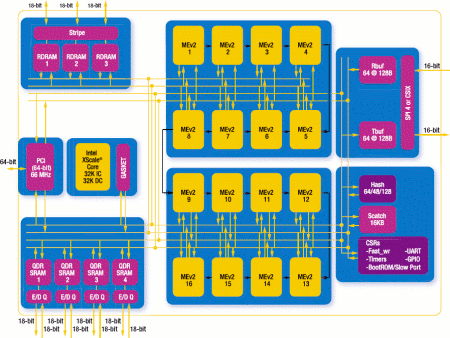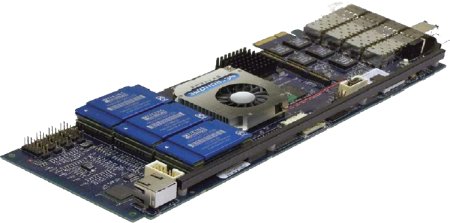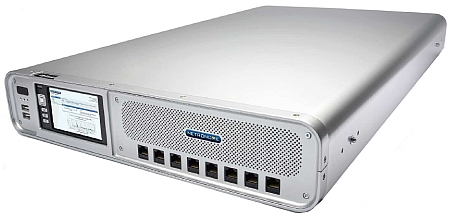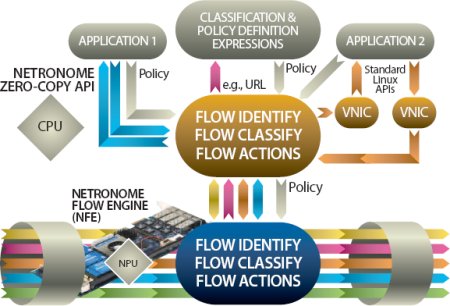High-end NPUs gain third-party backer
Nov 12, 2007 — by LinuxDevices Staff — from the LinuxDevices Archive — 6 views [Updated Nov. 15] — Netronome Systems has signed a multi-part licensing agreement with Intel around Intel's top-of-the-line network processor family. The agreement gives Netronome the right to market and support the IXP28xx through 2012, and to design and build next-generation IXP28xx chips with 10-100Gbps of… bandwidth.
[Updated Nov. 15] — Netronome Systems has signed a multi-part licensing agreement with Intel around Intel's top-of-the-line network processor family. The agreement gives Netronome the right to market and support the IXP28xx through 2012, and to design and build next-generation IXP28xx chips with 10-100Gbps of… bandwidth.
(Click for larger view of Netronome's NFE development toolkit)
Intel launched the IXP28xx family of NPUs (network processor units) in 2002. The chips combine ARM (XScale) application processing cores with multiple “MicroEngine” co-processors, and are touted as supporting up to 10Gbps of bandwidth.

IXP28xx architecture
(Click to enlarge)
Netronome, a four-year-old startup, is best known for its Netronome Flow Engine (NFE) line cards, as well as network appliances that integrate the NFE line cards. The company's cards and appliances are based on IXP28xx NPUs running MontaVista Linux, and are available with “Network Flow” tools aimed at letting developers use C/C++ and normal development techniques to program the IXP28xx chips' MicroEngines. The cards and appliances target telecom infrastructure equipment and high-end data processing equipment.

Network Flow Engine line card
(Click to enlarge)
The pact calls for continued production of existing IXP28xx models through 2012, with Netronome taking over full sales and support of current and future IXP28xx models. “Support,” here, appears to mean helping Intel with support for its IXA (Internet Exchange Architecture) tools during this period.
The deal also enables Netronome to develop new IXP28xx chips with throughput capabilities beyond 10Gbps. Jarrod Siket, senior VP of marketing at Netronome, told LinuxDevices, “The industry is moving from 10Gb to 40Gb and 100Gb and beyond. And, there are ever-increasing amounts of traffic requiring processing at layer 4-7.”
The agreement reportedly does not affect Intel's lower-end networking products, including its IXP-2400, IXP-1200, and IXP-400 models.
The four-year old Netronome has been shipping its IXP28XX-based Netronome Flow Engine (NFE) family of PCI Express coprocessor subsystems for a year now, said the company. Its product line includes Netronome Flow Processors, NFE-based networking boards and “Open Appliance Platform” turnkey appliances (shown below), as well as flow analysis and deep packet inspection development tools. Netronome's products are aimed at network access control, intrusion prevention and detection, unified threat management (UTM), and related high-end network security applications.

Netronome's Open Appliance 8100
(Click to enlarge)
Linux key to embedding network smarts
As broadband traffic increases, high-speed, intelligent flow analysis and processing are becoming increasingly important in switches, routers, and other appliances, said Siket. He added that Linux sits squarely in the middle of the trend toward embedding such functions in firmware to improve performance. The start-up uses MontaVista Carrier Grade Linux on its line cards, and supports “all major flavors” of Linux 2.6.1 or higher for application developers using its flow-control tools. “We've anchored ourselves on Linux and Intel's IXP,” said Sikit.
NPUs and their many MicroEngine coprocessors for flow control and security are notoriously difficult to program. Siket said Netronome's chief added value lies in its development tools for flow management. “Our main IP is our Flow Manager. We have tuned all of the IXP card features and exposed them as an API with a 700 page book. [Using it,] standard C developers can pull all the flow processor and analysis capabilities out of the chip.”

Netronome NFE tools
Netronome's competitors include Cavium, which offers up to 16-way designs that let network engineers program network flow functions in C/C++ on standard MIPS cores. Meanwhile, RMI offers something similar in the PowerPC world. Sikit thinks Netronome has an advantage over these competitors, however. He said, “Companies like Cisco and Juniper have gigantic engineering teams that develop for IXP, so there's a huge stickiness factor associated with moving away from it. [Thanks to our deal with Intel], they can move forward with confidence.”
Stated Doug Davis, VP/GM of Intel's Embedded and Communications Group (and the newest member of Netronome's board of directors), “The licensing of our technology will allow customers to continue their IXP hardware development and will provide the re-use of their existing tools, codebase and knowledge.”
Next Generation IXP
The new line of 10Gbps-and-faster, IXP-compatible network flow processors will more closely integrate the Intel IXP28XX with Netronome's network analysis architecture, explained Siket. The new version will span the network switching and routing functions of the L2-L3 layers to the L2-L7-layer flow analysis technology required by high-end network and security appliances. The processors will offer more sophisticated packet and flow classification, he said, and provide a more programmable design environment. The new products will be co-marketed by Intel and Netronome, which will continue to offer them in the form of chipsets, boards, and appliances.
In addition, the agreement calls for Netronome to be a networking application licensee for Intel's recently announced QuickPath Interconnect (QPI) technology. This high-speed on-chip interconnect is touted as a way to speed communications between network processors and host CPUs.
“Today our IXP cards communicate with the host over PCI Express, but QuickPath creates a dedicated electrical bus on the host board,” said Sikit. “It offers wider memory bandwidth, so a given processor can access data in memory that is attached to another processor, thereby increasing read-write.”
Availability
Neither Netronome nor Intel revealed when the next-generation 10Gbps IXP product is expected to ship.
This article was originally published on LinuxDevices.com and has been donated to the open source community by QuinStreet Inc. Please visit LinuxToday.com for up-to-date news and articles about Linux and open source.